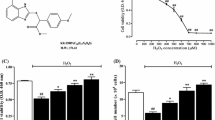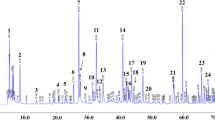Abstract
The present study was designed to investigate the cardio-protective effect of Ac-LEDH-cmk a selective caspase-9 inhibitor and 5-aminoisoquinolinone a selective Poly (ADP-ribose) polymerase inhibitor on ischemia and reperfusion induced apoptotic and necrotic cell death in rats. Isolated rat hearts were exposed to 30 minutes of global ischemia followed by 120 minutes of reperfusion using Langendorff’s apparatus. Myocardial injury was assessed in the terms of infarct size, release of lactate dehydrogenase, creatine kinase enzymes and apoptotic index was assessed by DNA smearing on agarose gel electrophoresis. Pretreatments with specific inhibitor of caspase-9, Ac-LEHD-cmk (0.07 μM and 0.105 μM), and inhibitor of PARP, 5-aminoisoquinolinone (5 μM and 7.5 μM), significantly attenuated I/R induced increase in infarct size, release of lactate dehydrogenase and creatine kinase in the coronary effluent, and apoptotic index. Therefore, it may be concluded that inhibition of caspase-9 and PARP prevent ischemia and reperfusion-induced activation of apoptotic cascade and necrosis in rat myocardium.
Similar content being viewed by others
References
Aleo, E., Henderson, C. J., Fontanini, A., and Solazzo, B., Identification of new compounds that trigger apoptosome independent caspases activation. Cancer Res., 66, 9235–9244 (2006).
Ausubel, F., Brent, R., Kingston, R. E., Moore, D., and Struhl, K. S., Preparation and analysis of DNA. In: Short protocols in molecular biology. John Wiley and Sons, Canada; pp. 2.8–2.9 (1995).
Baliga, R. R., Apoptosis in myocardial ischemia, infarction and altered myocardial states. Cardiology Clinics, 19, 91–12 (2001).
Banka, N., Anand, I. S., Sharma, P. L., and Wahi, P. L., Macroscopic measurements of experimental myocardial infarct size in rhesus monkey-a comparison of two methods. Bull. P.G.I, 15, 147–150 (1981).
Bennett, M. R., Apoptosis in the cardiovascular system. Heart, 87, 480–7 (2002).
Bhuiyan, M. S. and Fukunaga, K., Inhibition of HtrA2/Omi ameliorates heart dysfunction following ischemia/reperfusion injury in rat heart in vivo. Eur. J. Pharmacol., 557, 168–167 (2007).
Buja, L. M., Modulation of the myocardial response to ischemia. Lab. Invest., 78, 1345–73 (1998).
Chatterjee, P. K., Todorovic, Z., Sivarajah, A., Mota-Filipe, H., Brown, P. A., Stewrt, K. N., Cuzzocrea, S., and Thiemermann, C., Differential effects of caspase inhibitors on the renal dysfunction and injury caused by ischemia-reperfusion of the rat kidney. Eur. J. Pharmacol., 503, 173–183 (2004).
Chopra, K., Singh, M., Kaul, N., and Ganguly, N. K., Decrease of myocardial infarct size with desferroxamine, possible role of oxygen free radicals in its ameliorative effect. Mol Cell Biochem., 85, 71–76 (1992)
Collinson, P. O. and Gaze, D. C., Biomarkers of cardiovascular damage. Med. Princ. Pract., 16, 247–261 (2007).
Cowburn, A. S., White, J. F., Deighton, J., Walmsley, S. R., and Chilvers, E. R., z-VAD-fmk augmentation of TNF alpha-stimulated neutrophil apoptosis is compound specific and does not involve the generation of reactive oxygen species. Blood, 105, 2970–2972 (2005).
Cully, J. D., Wakiyama, H., Hsieh, Y. J., Jones, M., and Levitsky, S., Differential contribution of necrosis and apoptosis in myocardial ischemia-reperfusion injury. Am. J. Physiol. Heart Circ. Physiol., 286, H1923–H1935 (2004).
Fiorillo, C., Ponziani, V., Giannini, L., Cecchi, C., Celli, A., Naxii, N., Lanzilao, L., Caporale, R., and Nassi, P., Protective effects of the PARP-1 inhibitor PJ34 in hypoxicreoxygenated cardiomyoblasts. Cell Mol. Life Sci., 63, 3061–3071 (2006).
Fishbein, M. C., Meerbaum, S., Rit, J., Lando, U., Coroday, E., and Ganz, W., Early phase acute myocardial infarct size quantification: validation of the triphenyltetrazolium chloride tissue enzyme staining technique. Am. Heart J., 101, 563–600 (1981).
Hughes, B., A method for the estimation of serum creatine kinase and aldolase activity in normal and pathological sera. Clin. Chim. Acta., 7, 597–593 (1961).
Jiang, B., Xiao, W., Shi, Y., Liu, M., and Xiao, X., Heat shock pretreatment inhibited the release of Smac/DIABLO from mitochondria and apoptosis induced by hydrogen peroxide in cardiomyocytes and C2C12 myogenic cells. Cell Stress Chaperones, 10, 252–262 (2005).
King, J., A routine method for the estimation of lactic dehydrogenase activity. J. Med. Lab.Tech., 16, 265–272 (1959).
Langendroff, O., Untersuchngen am Uberlebender saugethierherzen. Pflunger Archiv Fur Die Gesmate Physiologic., 61, 291–32 (1895).
Liu, H. R., Gao, E., Hu, A., Tao, L., Most, P., Koch, W. J., Christopher, T. A., Lopez, B. L., Alnemri, E. S., Zervos, A. S., and Ma, X. L., Role of Omi/HtrA2 in apoptotic cell death after myocardial ischemia and reperfusion. Circulation, 111, 90–96 (2005).
Lu, K., Otani, H., Yamamura, T., Nakuo, Y., Hattori, R., Ninomiya, N., Osako, M., and Imamura, H., Protein kinase c isoform dependent myocardial protection by ischemic preconditioning and K+ cardioplegria. J. Thorac. Cardiovas. Surg., 121, 137–148 (2001).
Maulik, N., Yoshida, T., Das, D. K., Regulation of cardiomyocyte apoptosis in ischemic reperfused mouse heart by glutathione peroxidase. Mol. Cell Biochem., 196, 13–1 (1999).
Nayler, W. G., Gordon, M., Stephens, D. J., and Sturrack, W. J., The protective effect of prazosin on ischemic and reperfused myocardium. J. Mol. Cell Cardiol., 17, 685–699 (1985).
Omar, B. A., Hanson, A. K., Bose, S. K. et al., Reperfusion with pruvate eliminates ischemic preconditioning in isolated rabbit heart: an apparent role for enhanced glycolysis. Artery Dis., 2, 799–04 (1999).
Perrin, C., Ecarnot-Laubriet, A., Vergely, C., and Rochette, L., Calpain and caspase-3 inhibitors reduce infarct size and post-ischemic apoptosis in rat heart without modifying contractile recovery. Cell Mol. Biol., 49, 497–05 (2003).
Radovits, T., Seres, L., Gero, D., Berger, I., Szabó, C., Karck, M., and Szabó, G., Single dose treatment with PARPinhibitor INO-1001 improves aging-associated cardiac and vascular dysfunction. Exp. Gerontol., 42, 676–5 (2007).
Rupinder, S. K., Gurpreet, A. K., and Singh, M., Cell suicide and caspases. Vascul. Pharmacol., 46, 383–393 (2007).
Schreiber, V., Dantzer, F., Ame, J. C., and de Murica, G., Poly (ADP-ribose): novel functions for an old molecule. Nat. Rev. Mol. Cell Biol., 7, 517–518 (2006)
Song, Z. F., Ji, X. P., Li, X. X., Wang, S. I., Wang, S. H., and Zhang, Y., Inhibition of the activity of Poly(ADP-Ribose) Polymerase reduces heart ischemia/reperfusion injury via suppressing JNK mediated AIF translocation. J. Cell Mol. Med., 2007; (Epub ahead of print).
Stegh, A. H. and Peter, M. E., Apoptosis and caspases. Cardiology Clinics, 19, 13–29 (2002).
Szabo, C., Cardioprotective effects of poly (ADP-ribose) polymerase inhibition. Pharmacol. Res., 52, 34–3 (2005).
Szabo, G., Liaudet, L., Hagl, S., and Szabo, C., Poly (ADPribose) polymerase activation in the reperfused myocardium. Cardiovas. Res., 61, 471–480 (2004).
Tiziano, M., Scarabelli, Anastatis, S., Pasini, E., Comini, L., Raddino, R., Knight, R., and Latchman, D. S., Different signaling pathways induce apoptosis in endothelial cells and cardiac myocytes during Ischemia reperfusion injury. Cir. Res., 90, 745–750 (2002).
Vanden, T. L., Qin, Y., Wojcik, K. et al., Reperfusion and not simulated ischemia initiates apoptosis injury in chick cardiomyocytes. Am. J. Physiol. Heart Circ. Physiol., 284, H141–H50 (2003).
Veronique, J., Bouchard, N., Michele, R., and Guy, P., PARP-1, a determinant of cell survival in reponse to DNA damage. Expt. Hemat., 31, 446–4 (2003).
Virag, L. and Szabo, C., The therapeutic potential of Poly (ADP-Ribose) Polymerase inhibitors. Pharmacol. Rev., 54, 375–29 (2002).
Wang, Y., Hirari, K., Ashrag, M., Activation of mitochondrial ATP-sensitive K+ channel for cardiac protection against ischemic injury is dependent on protein kinase c activity. Circ. Res., 85, 731–1 (1999).
Wayman, N., McDonald, M. C., Thompson, A. S., Threudgrll, M. D., and Thiewermann, C., 5-aminoisoquinolinone, a potent inhibitor of poly (adenosine 5′-diphosphate ribose) polymerase, reduces myocardial infarct size. Eur. J. Pharmacol., 430, 93–100 (2001).
Young, K., Zhang, T., and Kraus, W. L., Poly(ADPribosyl) ation by PARP-1: ‘PAR-laying’ NAD into a nuclear signal. Genes Dev., 19, 1951–1967 (2005).
Zhao, Z. Q., Nakamura, M., Wang, N. P., Wilaox, J. N., Shearer, S., Ronson, R. S., Guyton, R. A., and Vinten-Johansen, J., Reperfusion induces myocardial apoptotic cell death. Cardiovasc. Res., 45, 651–660 (2000)
Author information
Authors and Affiliations
Corresponding author
Rights and permissions
About this article
Cite this article
Sodhi, R.K., Singh, M., Singh, N. et al. Protective effects of caspase-9 and poly(ADP-ribose) polymerase inhibitors on ischemia-reperfusion-induced myocardial injury. Arch. Pharm. Res. 32, 1037–1043 (2009). https://doi.org/10.1007/s12272-009-1709-9
Received:
Revised:
Accepted:
Published:
Issue Date:
DOI: https://doi.org/10.1007/s12272-009-1709-9




